Yumai Bishop
Abstract:
It is widely disputed that the ark of Noah which appears in the Biblical text would float if it did exist at all. Drawing from a study done by the students of Leicester, a model experiment was conducted in the following fashion: The verifiability of a floating ark was tested in a laboratory setting by constructing the said ark on a smaller scale in two prototypes and measuring the buoyancy force at differing water volumes with non-saline and saline solution (35 ppt). From the buoyancy force, weight, and density measured, it was suggested that an ark built in the Biblical dimension would float in a laboratory setting. This experiment reviewed the calculations done by the students of Leicester as a physically testable thesis.
Introduction:
There are many controversies in the Bible, especially concerning Biblical events. One of the most debted events that affect the entire branch of creationism is Noah’s Ark. Some say that it’s one version of a myth repeated in close to 300 other cultures, such as in the Epic of Gilgamesh. (Delitzsch, 2016) Others are sceptical of the existence of the Ark, as many failed the questionable quests for the Ark supposedly in Turkey. (Kruczy, 2010) And even if it did exist, can such a thing float? Yet some others believe this to be true and possibly be backed with science. (Herlingshaw et al, 2014) The question remains: Can Noah’s Ark float if it did exist at all?
This project involved building a scaled-down model of Noah’s Ark (possibly somewhere at 1/600 of the original) and testing its ability to float on water using the dimensions given in the ancient Hebrew text, the Bible. (Zondervan, 2005) The rest of the details can be seen from the blueprint in the Materials and Methods section constructed from various sources of replicas. (Rivera, 2016; Lovett, 2007) The four ark prototype models were tested on a body of water that was to be said to have covered the earth according to the flood. This amount is rather hard to place (as there are discrepancies to the geographical attributes of the earth in Noah’s time, placed to be around 2348BC) (Brückner and Engel, 1970), so this was modified to different amounts calculated from the ark density and buoyancy force. There would be three steps at this stage: The first would be to see if it can float on a certain body of water, the second to see if this would change by the weight (nails) placed inside, and the third, the angle of water it can handle without capsizing. These factors would all be measured with varying amounts of water poured in at an increasing 5L each time up to 20L (5L, 10L, 15L, and 20L).
Previous and grander scales of replicating Noah’s Ark are the ones around the world such as Johan’s Ark in the Netherlands, Ark Encounter in Kentucky, and the one in Hong Kong (Ark Of Noah Foundation, et al. 2019). Except for Johan’s Ark, none of these arks floats. Others have replicated it on smaller levels, but as far as it was researched, there are not many examples of someone actually testing this in a laboratory setting. One study by Physics students from the University of Leicester (Herlingshaw et al, 2014) established calculations that theorized the possibility of a floating ark, but whether the event happened is an entirely different question (Thompson, 2014). So in this experiment, the focus solely was on the plausibility of a floating ark, not the existence of the ark itself.
Materials and Methods:
The original dimensions that are given in the Bible in the book of Genesis 6:14-16 states that it was 300 cubits long, 50 cubits wide, and 30 cubits high. Since a cubit is anywhere from 45.5-52.3cm, The average of that number, which is 48.2cm, was used for this experiment. This meant that the dimensions were 14460 cm length, 2410 cm width, and 1446cm height. A scale of 1/600 would be 24.1 cm length, 4.02 cm width, and 2.41 cm height. (Averaged to the nearest centimetres.) The wood used is listed as Gopher, an unknown wood but possibly pine, cedar, or cypress. Since these are all hardwood that is difficult to come by in smaller sizes, birch, another durable hardwood, was used for this experiment.
The birch wood was cut into the following dimensions (Western Nameplates):
24 by 4 cm, 24 by 2 cm, and 4 by 2 cm. Two of each board were cut, then four of these sets of wood were laser cut. One set contained six board pieces. The total number of cut wood was 24 pieces.
The pre-cut birch wood pieces were put together into two model types:
Straight Bow Rectangular and Straight Bow Angular. (Straight bow meaning a 90-degree hull.)
Two of each build was constructed for variable control. They were glued together using Waterproof Grade II Wood Glue (Gorilla Wood Glue). The edges were sanded off for safety purposes. For model type 2, the long edges were cut off at a 20º angle, the portsides pieces were cut off 0.8cm on both ends, and the bow and stern pieces were cut into two to give it the 20º angle from the sides. Since there was no incline, the bow and stern both maintained the straight angle, which was common for all the model types.
After the models were constructed, they were varnished with a brush using Varathane (Stain & Polyurethane, Classic Oak Stain) on the inside and the outside. This process of varnishing was repeated three times for the waterproofing method (total of three waterproof coatings). In between the coatings, each layer was sanded to give a smoother coat.
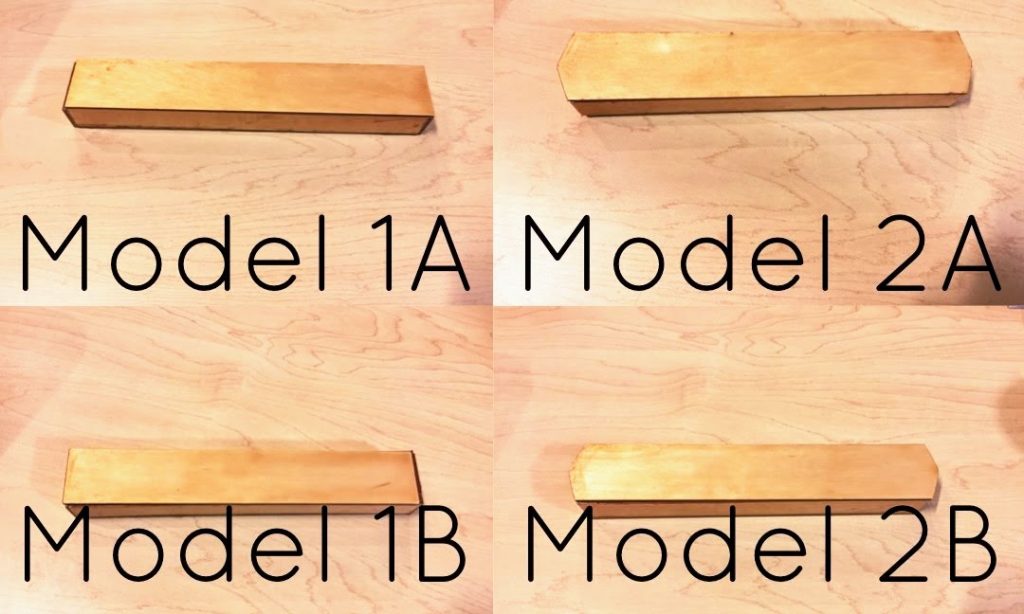
Figure 1. Ark models by type
When each coating had dried and had been sanded, the arks were put to three experimental tests: No Weight, With Weight, With Weight Saline.
For all of the tests, all the models were placed in the water volumes of 5L, 10L, 15L and 20L. Every time each build was placed in the water, the volume of the ark submerged in the water was measured using a ruler to find its buoyancy.
In the No Weight trial, nothing was placed inside the ark during the tests.
In the With Weight trial, nails (0.21105kg) were placed inside the ark, then the lids were taped using plastic tape to prevent water from entering between the gaps. After this, the models were placed in water and measured.
In the With Weight Saline trial, nails were placed inside the ark and the ark taped like the With Weight trial. Unlike the With Weight trial, however, the water contained salt (35 parts per thousand of water mass, or 3.5% of water mass), which was 0.68kg NaCl for 20L of water.
Results:
The ark was constructed over a period of little over a month, although it was initially planned in a time-frame of three weeks. This was due to the long hours it took to dry each of the coats.
The question, Can Noah’s ark float? was answered in the three stages of experimentation where buoyancy was calculated. From the straight conversion of density conversion of the ark itself (Table 1), it can be observed that it is significantly less than that of water (Table 2). Even when it is compounded with the weight of the nails, its density was still less than that of water. From this point, it was hypothesized that the ark would float, both with weight and without weight.
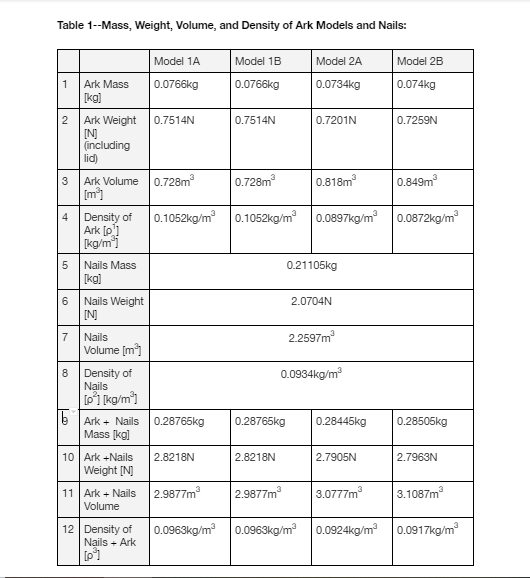
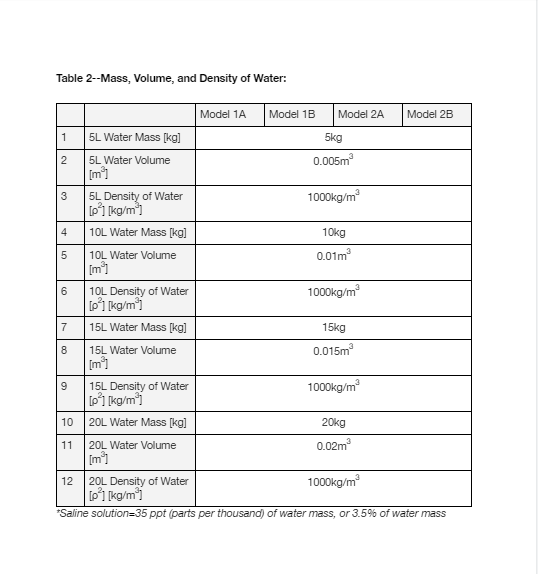
In the actual experimentation, the No Weight trials all yielded a consistent stronger buoyancy force than the force of gravity or the weight of the ark (Figure 2). It had varying buoyancy forces across the builds for the With Weight trials, although the 1A and 1B models had the same buoyancy force in the water volumes of 5L and 15L (Figure 2). From these points, all of the models in this trial floated on the water.
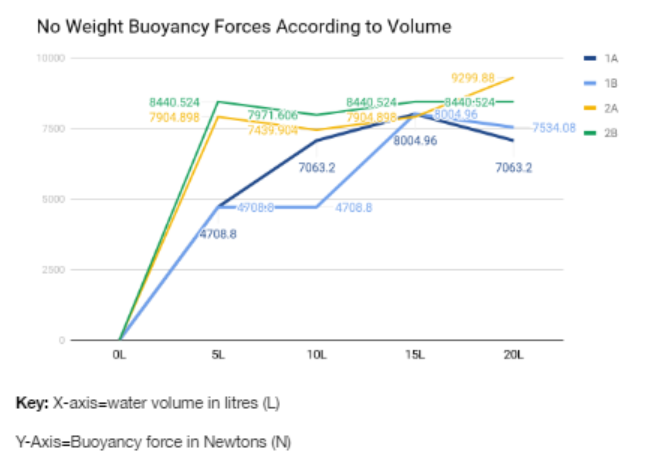
Figure 2. No weight buoyancy forces according to volume.
The With Weight trials was troubleshot across three weeks in the actual experimentation due to the fact water kept leaking into the ark models from a small gap between the lid. This was solved by using plastic tape to cover all the gaps accordingly. In this trial, the buoyancy force decreased from that of the No Weight trial (Figure 3) by almost half to three-quarter. The weight of each ark model with weight also increased around 3.7 times the no weight trial (Table 1, row 2 v. row 5). All of the models’ buoyancy force surpassed that of their weight, but in the 10 L trial, model 2A did not float and was submerged in the water (Figure 3). Although this specific model’s 10L trial was repeated three times by re-wrapping the tape, it submerged each time. The rest of the models floated on the water.
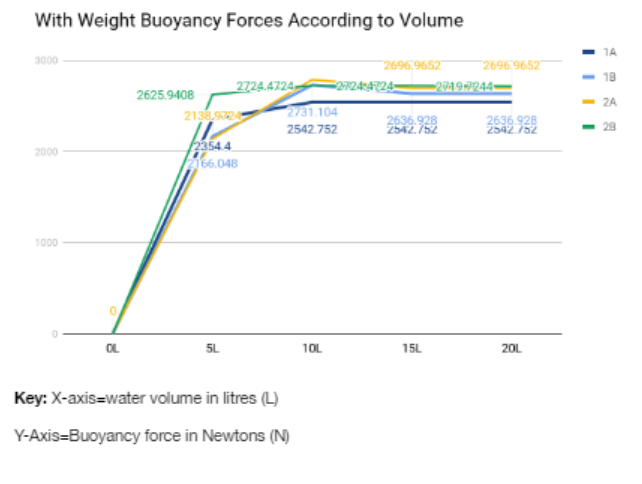
Figure 3. With weight buoyancy according to volume.
Lastly, in the With Weight Saline trial, all the models yielded the same buoyancy force according to the build across the volumes (Figure 4). In this trial, all the models floated. Due to the shortage of time (see point above on varnishing time frame), the 15L and 20L trials could not be conducted.
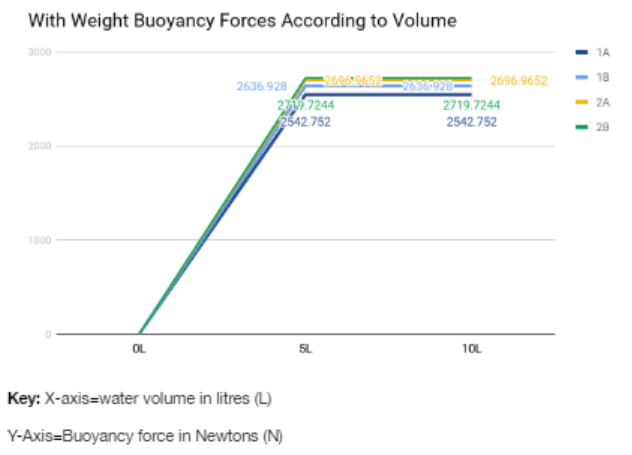
Figure 4. Saline with weight buoyancy forces according to volume.
Discussion:
From the results above, it could be suggested that Noah’s ark floated. However, there was one model in specific which did not float at a volume (see the point in the Results on With Weight trial, model 2A at 10L). Since model 2A floated on all other trials, it is likely that this was due to the way the plastic tape was wrapped, since the water was found inside after the three times it was experimented on. The presence of water inside model 2A in the 10L trial suggests that the leak may have led to its sinking. Other models also had a similar problem but after a few rounds of troubleshoots, tended to resolve this specific problem. Model 2A’s 10L trial was cut short at three tries due to time constraint, so in the future, additional tries and troubleshoots could yield a different result.
Also, since this was a crude model of what the ark could have been, it may not represent an actual boat at the grander scale with the full weight, since the angles used to construct the ark models were all generally straight. Modern shipbuilding techniques on tankers (Tupper, Eric C 2013) were also taken into consideration, although the emphasis of this experiment was placed on the ark–a boxed typed large ship (Merriam-Webster 2020). In the future, possible experiments could answer the question of what would happen to buoyancy as one increases the size, as well as changing the water landscape. For example, this experiment was conducted solely on a flat surface inside the bucket. Adding sand and dirt can change the water landscape and may affect the buoyancy of the ark. Increasing the ark scale up to 1/300 can also affect how the ark holds up and carries the weight. Other factors that would be relevant to look into are causing artificial waves and/or changing hull types to a rounder angle. By combining a series of these scenarios (increasing the model size, changing the water landscape, causing artificial waves), one could better evaluate how this ark could have operated.
Although this experiment talked about the technicality of a floating ark, the implications it has for the modern world is much broader. As touched upon in the Introduction section, there are various controversies with ancient texts, especially ancient religious texts. This has led to conflicting worldviews among individuals and wider conflicts worldwide that stems from the difference of worldviews. (Koch and Yannis 2019) By tackling the said discrepancies from a scientific vantage, these kinds of conflicts can better be understood by opposing parties. (Tang and Xiangyu 2017) It would also better give light to archaeological studies focusing on the ancient ship-building techniques, transportation models, and climate change symptoms. Overall, this experiment not only dealt with the direct question of a feasible floating ark, but also with the mindset and historical implications it could have. Further experimentation could offer better insight on these topics.
At the conclusion
of this experiment, it was suggested that a straight angled ark would float in
a laboratory setting.
References:
“Ark.” Merriam-Webster.com Dictionary, Merriam-Webster, https://www.merriam-webster.com/dictionary/ark. Accessed 16 Apr. 2020.
Ark, Noah’s. “Welcome To Noah’s Ark Hong Kong – A Great Attraction In Hong Kong”. Noahsark.Com.Hk, 2019, https://www.noahsark.com.hk/eng/index.jsp. Accessed 28 Sept 2019.
“Ark Of Noah, The Life-Size Noah’s Ark”. Ark Of Noah Foundation, 2019, http://arkofnoah.org/. Accessed 28 Sept 2019.
Brückner, Helmut, and Max Engel. “Noah’s Flood-Probing an Ancient Narrative Using Geoscience.” SpringerLink, Springer, Cham, 1 Jan. 1970, link.springer.com/chapter/10.1007/978-3-030-23315-0_7.
DELITZSCH, FRIEDRICH. BABEL AND BIBLE: a Lecture on the Significance of Assyriological Research for Religion (Classic … Reprint). FORGOTTEN Books, 2016.
Encounter, Ark. “About The Life-Size Noah’S Ark”. Ark Encounter, 2019, https://arkencounter.com/about/. Accessed 28 Sept 2019.
Herlingshaw, Katie et al. “P2_4 Noah’S Ark: The Story Continues…”. www.108.Lamp.Le.Ac.Uk, 2014, https://www108.lamp.le.ac.uk/ojs1/index.php/pst/article/view/2192/2096. Accessed 28 Sept 2019.
Koch, Bettina, and Yannis A. Stivachtis. Regional Security in the Middle East. E-International Relations Publishing, 2019. Accessed 20 Apr. 2020.
Kruczy, Stephen. “Doubt Cast on Noah’s Ark Found in Turkey.” The Christian Science Monitor, The Christian Science Monitor, 28 Apr. 2010, www.csmonitor.com/World/Global-Issues/2010/0428/Doubt-cast-on-Noah-s-ark-found-in-Turkey.
Kruczy, Stephen. “Chinese Explorers Stand by Claim of Noah’s Ark Find in Turkey.” The Christian Science Monitor, The Christian Science Monitor, 30 Apr. 2010, www.csmonitor.com/World/Global-Issues/2010/0430/Chinese-explorers-stand-by-claim-of-Noah-s-Ark-find-in-Turkey.
Lovett, Tim. “Thinking Outside the Box: Size and Shape of the Ark.” Answers in Genesis, Answers in Genesis, 19 Mar. 2007, answersingenesis.org/noahs-ark/thinking-outside-the-box/.
Rivera, David. “Media.” Ark of Noah Foundation, Ark of Noah Foundation, Feb. 2016, arkofnoah.org/media/.
Tang, Kok-Sing, and Xiangyu Yang. “Student Agency in Negotiating the Relationship Between Science and Religion.” Research in Science Education, vol. 49, no. 5, 22 Aug. 2017, pp. 1301–1317., DOI:10.1007/s11165-017-9655-x.
The Holy Bible: New International Version. Zondervan, 2005.
Thompson, Helen. “Could Noah’S Ark Float? In Theory, Yes”. Smithsonian, 2014, https://www.smithsonianmag.com/science-nature/could-noahs-ark-float-theory-yes-180950385/. Accessed 28 Sept 2019.
Toups, Irby. “Noah’s Ark”. Mishkanministries.Org, 2005, http://www.mishkanministries.org/noahs_ark.htm. Accessed 28 Sept 2019.
Tupper, Eric C. “Ship Design.” Ship Design – an Overview | ScienceDirect Topics, Science Direct, 2013, www.sciencedirect.com/topics/engineering/ship-design.